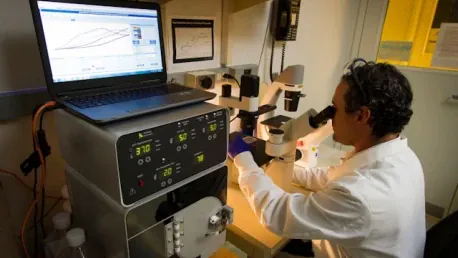In recent years, the field of cancer diagnostics has witnessed remarkable advancements, particularly in early detection and risk assessment. These innovations are transforming how we approach cancer prevention and treatment, offering hope for millions worldwide. This article delves into the latest technologies and methodologies that are revolutionizing cancer detection, with a focus on personalized risk assessments and early intervention strategies.
The Rise of Liquid Biopsies
Understanding Liquid Biopsies
Liquid biopsies represent a groundbreaking shift in cancer diagnostics. Unlike traditional biopsies, which require tissue samples, liquid biopsies use blood tests to detect cancer. This non-invasive method is not only more comfortable for patients but also allows for earlier detection of cancerous cells. By analyzing circulating tumor DNA (ctDNA) in the bloodstream, liquid biopsies can identify cancer at its nascent stages, significantly improving the chances of successful treatment.
The methodology behind liquid biopsies hinges on the ability to capture and analyze minute quantities of ctDNA released into the blood from cancer cells. This approach has transformed the diagnostic landscape, as it enables continuous monitoring of tumor mutations and dynamics. The implications for clinical practice are vast, offering oncologists critical insights into disease progression and response to therapy without resorting to more invasive procedures. Moreover, this technique can provide a more comprehensive picture of heterogeneity within tumors, potentially guiding more personalized treatment strategies.
Benefits and Applications
The benefits of liquid biopsies extend beyond early detection. These tests can also monitor the progression of cancer and the effectiveness of treatments. For instance, Guardant Health’s Shield™ test, approved by the FDA in 2024, is a prime example of how liquid biopsies are being used for colorectal cancer screening. This test provides a less invasive alternative to colonoscopies, encouraging more people to undergo regular screenings and catch cancer early.
Additionally, liquid biopsies play a crucial role in identifying resistance mechanisms to targeted therapies. Cancer often evolves resistance to treatments, posing challenges to long-term disease control. Liquid biopsies allow for the early identification of resistance mutations, enabling timely adjustments in therapeutic approaches. Furthermore, the non-invasiveness and repeatability of liquid biopsies make them ideal for tracking tumor evolution, helping physicians make informed decisions throughout the course of treatment. These advancements underscore the broadening applications of liquid biopsies, from initial diagnosis and periodic screening to meticulous tracking of therapeutic outcomes.
Personalized Risk Assessment
Integrated Polygenic Risk Score (iPRS)
One of the most significant advancements in personalized cancer risk assessment is the development of the integrated polygenic risk score (iPRS). Natera, in collaboration with MyOme, has introduced this innovative test for personalized breast cancer risk assessment. The iPRS offers a more refined method to estimate both five-year and lifetime breast cancer risk, particularly for individuals who test negative for hereditary cancer through Natera’s Empower test.
By leveraging large-scale data and advanced genetic algorithms, the iPRS provides a comprehensive evaluation of an individual’s predisposition to breast cancer. This method integrates multiple genetic markers, enhancing the precision of risk predictions and enabling more tailored preventive measures. For individuals who test negative for known hereditary cancer mutations, this test fills a critical gap, offering insights based on a broader genetic landscape. The result is a more nuanced understanding of cancer risk that goes beyond traditional gene mutation testing, paving the way for personalized healthcare strategies.
Impact on Breast Cancer Prevention
Considering that one in eight women will be diagnosed with breast cancer in their lifetime, the iPRS is a crucial tool in enhancing vigilance and potentially saving lives. By providing a personalized risk assessment, this test empowers individuals to take proactive measures in managing their health. This could include more frequent screenings, lifestyle changes, or preventive treatments, all aimed at reducing the risk of developing breast cancer.
The application of iPRS in clinical settings marks a significant step toward precision medicine, where interventions are customized based on individual risk profiles. Women identified with higher risk scores can engage in closer surveillance and consider pharmacological or surgical interventions to mitigate their risk. Public health programs can also benefit from these assessments by identifying high-risk populations, tailoring education efforts, and optimizing resource allocation. Ultimately, the integration of iPRS into routine medical practice represents an evolution in preventive medicine, emphasizing proactive approaches over reactive treatment and striving for early intervention to combat breast cancer more effectively.
The Broader Impact of Diagnostic Innovations
Transformative Trends in Cancer Diagnostics
The advancements in cancer diagnostics are part of a broader, transformative trend in the healthcare industry. Companies like Exact Sciences, Veracyte, and Grail are at the forefront of developing new diagnostic technologies. These companies are part of the Diagnostics, Genomics, and Precision Medicine subsectors of the ROBO Global Healthcare Technology and Innovation Index (HTEC), which supports investor awareness and involvement in these innovations.
These diagnostic pioneers are driving a significant paradigm shift, pushing the boundaries of what is possible in early cancer detection. Exact Sciences, for example, has made significant strides in non-invasive colorectal cancer screening, while Grail focuses on multi-cancer early detection tests. Veracyte, known for its genomic classifiers, aims to improve diagnostic clarity in lung cancer and other malignancies. The contribution of these companies to the field underscores the growing emphasis on precision medicine, leveraging genomic data and advanced molecular techniques to refine diagnostics, prognostics, and treatment strategies.
The Role of Technology in Early Detection
The integration of advanced technologies in cancer diagnostics is crucial, especially given the aging population. The United Nations projects that by 2050, one in four people in Europe and North America will be aged 65 or older. Early detection and personalized risk assessment empower individuals to manage their health proactively, potentially preventing the onset of cancer. This ensures that individuals receive timely and effective treatments, improving their quality of life.
Technology’s role extends beyond molecular diagnostics, encompassing artificial intelligence and machine learning to interpret complex data and improve decision-making processes. AI algorithms can sift through vast datasets, identifying patterns and markers indicative of early cancer stages that might be missed by traditional methods. Moreover, wearable health devices and digital health tools are becoming integral to continuous health monitoring, allowing for real-time data collection and analysis. These technological advancements not only facilitate early cancer detection but also foster a more integrated approach to health management, where data-driven insights guide preventive measures and individual care plans.
The Quiet Revolution in Cancer Diagnostics
Subtle Yet Significant Changes
The ongoing revolution in cancer diagnostics may be quiet, but its impact is profound. The steady stream of innovations promises a future where cancer can be anticipated and possibly averted. This shift towards early detection and prevention is transforming health management, offering hope for millions of people worldwide.
The quiet nature of this revolution lies in its seamless integration into daily clinical practice and public health initiatives, subtly yet significantly altering the trajectory of cancer care. Emerging diagnostic tools are being embedded in routine check-ups, empowering healthcare providers with more accurate and early identification capabilities. This shift is fostering a healthcare environment where preventive measures are prioritized, and the emphasis is on maintaining health rather than merely treating disease. The culmination of these efforts is a gradual but impactful change in public health outcomes, reducing cancer incidence and improving survival rates through early and effective intervention.
Societal Benefits of Early Detection
The societal benefits of early cancer detection are immense. By catching cancer early, treatments are more likely to be successful, reducing the overall burden on healthcare systems. Moreover, early detection can lead to better patient outcomes, lower healthcare costs, and improved survival rates. This revolution in cancer diagnostics aligns with the broader healthcare strategy of integrating technological advances to achieve substantial societal benefits.
Early detection contributes to fewer advanced cancer cases, which are typically more complex and expensive to manage. As a result, healthcare systems can allocate resources more efficiently, focusing on preventive care and patient education. Moreover, the shift towards early detection fosters a proactive public health culture, where individuals are more engaged in their health management and aware of the importance of regular screenings. Educational campaigns emphasizing the significance of early diagnostics galvanize community action, supporting a collective effort to mitigate cancer’s impact. Ultimately, the societal benefits encapsulate improved quality of life, economic savings, and a more resilient public health structure poised to confront future challenges effectively.
Conclusion
In recent years, the field of cancer diagnostics has seen significant advancements, particularly in early detection and risk assessment. These breakthroughs are reshaping our approach to cancer prevention and treatment, instilling hope for millions around the globe. By leveraging new technologies and innovative methodologies, medical professionals are now equipped to diagnose cancer at much earlier stages, potentially improving patient outcomes. This article explores these cutting-edge advancements, emphasizing how personalized risk assessments and early intervention strategies are transforming the landscape of cancer detection. By focusing on unique genetic markers and employing advanced screening techniques, these new methods offer a more tailored and proactive approach to identifying and managing cancer risks. The integration of artificial intelligence and machine learning further enhances the precision and accuracy of diagnostics, paving the way for more effective, individualized treatment plans. As a result, these developments are not only improving survival rates but also enhancing the overall quality of life for cancer patients.









